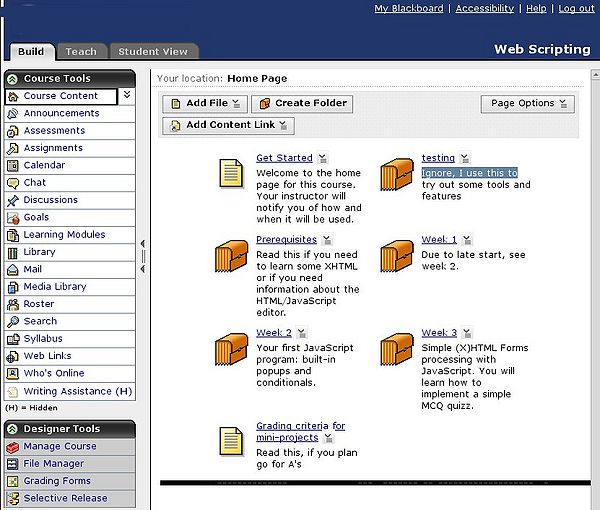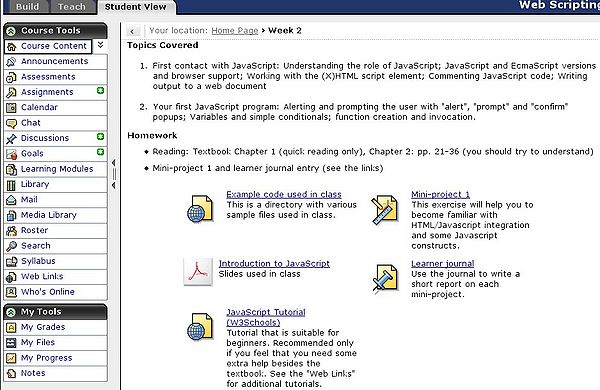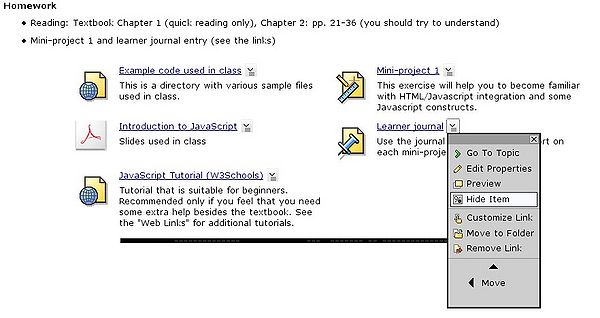Blackboard Vista
<pageby nominor="false" comments="false"/>
Definition
Blackboard Vista is a commercial learning management system (LMS). Blackboard Inc. sells several products. A first LMS, branded "Blackboard", was (probably) available in 1997. This entry describes Blackboard Vista (2008), i.e. just one of Blackboard's products. It is derived from WebCT VISTA, if we understand right. WebCT was one of the first LMSs adopted by higher education.
This entry describes a few features of this LMS, provides some hints and includes some discussion.
Interfaces overview - designer, teacher, student and my
Course designers, teachers and students can use different tool sets available through different views. A course designer/teacher has access to all three views. Here is a short overview:
- Course designers (Build) view - used to create courses:
- Course tools: Configuration/Design of contents, communication and evaluation tools.
- Designer tools: in particular "manage course" to configure course tools (e.g. remove/add from the available list), appearance, file management, etc.
- Teacher (Teach) view - used while teaching a course:
- Course tools (the same as above, but for use)
- Instructor tools: course, assessment, grading management, tracking etc. plus "manage course" tools.
- Student view:
- Course tools: same as the course designer and teacher
- My tools (student tools): evaluation and progress tracking
- As a course designer you may test drive your course with a "test student" ID, i.e. you can click on "Student view".
Below is a screenshot that shows the three views (tabs on to left), the course and designer tools menu and the workarea to the right.
In some institutions, teachers may only have access to the "teach view". I.e. these teacher are mosre like tutors, they use Vista to manage a class, but they can't change the design of course (sequences or resources).
Finally, each user has a "My Blackboard" page.
- It can be configured to include various "channels" (tools). e.g. Course list, Aggregated calendar, some bookmark tools etc. Channels can be made mandatory or inaccessible by the site administrator.
- Is also allows to change the profile
- The "Content Manager" tab in the "my tool" (not shown here) gives central access to all files created
Course design - tools + sequencing
To design a course, you basically define activities that learners should do over time using different resources (contents and tools).
Let's first look at the palette of available resources. Both tools and contents are available through the course tools menu.
Course tools
In Vista speak, course tools refer to all tools that will be used by learners. Course designers have to select and configure tools, add contents and maybe "arrange" (i.e. sequence) learner activities.
A course is arranged around "Course Content" (first item in course tools) or around Learning Modules or simply around the Course tools menu providing direct access to all tool sets. Course tools refer a set of tools we shall outline below. They are available to designer, instructor and student (although in different ways).
Items of the course tools menu can be hidden from students. You may link to some tool (or rather instances of these tools) from various places. E.g. from a course content folder you may link to a specific forum.
There exist four families of course tools:
- Content tools
- Course content tool. It allows to create (and move) folders (and sub-folders) and to link to other resources (tools and contents).
- You also can add files to the system, i.e. create an HTML content with an editor or download it from your own computer. All files can be managed through the File Manager (designer tools), but file insertion and creation also can be initiated through the course content tool for example.
- Learning modules (are multi-page XHTML documents plus links to course tools organized into a tree)
- SCORM modules, probably IMS CP and SCORM 1.2 you can load and then use
- Some communication tools, in particular discussions also can be used to create contents.
- Web links manager (students also can be allowed to add links)
- Library (this can be site-wide configured, e.g. organize access to restricted resources)
- Communication tools
- Announcements. A tool to make announcements visible in a central local
- Chat.
- Discussions, i.e. Forums (threaded topics), a collective blog, or journals.
- Who is online
- Student Roster. Students can edit their profile, e.g. add a picture
- Learning activities
- Quizzes, test, surveys
- Assignments
- Discussion tools (see above). These are gradable.
- Goals tool (define goals for students to achieve, can be linked to contents)
- There exist (in the release I am working with) no "construction tools" like collaborative wikis or concept maps
- Organizational tools
- Calendar
- Search
- Syllabus
Depending on how permissions are set up, you can configure most of these course tools. "Build view" gives more options than "Teach View". There are 2 configuration opportunities:
- When you use a tool as designer (e.g. when you create a discussions category or add a page/file.)
- In the "Manage Course" page, click on "Settings". This will lead to a "Settings Management" page through where you can set various rights for given tools for different user categories (e.g. students and teaching assistants).
A note on terminology: WebCT sometimes uses a somewhat strange terminology and that may be a bit confusing. E.g. "tools" are called "contents", "pages" you create are called "files" (because they become files). "Add Content Link" means that you can add tools (including content tools other than simple files). You'll have to get used to this...
Course organization
Organization of contents can be done in several ways. We will describe three.
(1) You may decide to use just a small selected subset of course tools (e.g. forums and assignments) and then maybe add folders to the default page and that include some contents. In this case, students will use various tools according to their needs (e.g. they will directly click on assignments in the course tools bar). This is a recommended minimal configuration for classroom teaching.
(2) Use may create folders in the course content tool. Each folder then could represent a learning unit. E.g. you could organize a class by topic or lessons (week 1, week 2, etc.) by creating a folder for each. You then can add course tools ("add content links") to each folder. In this case, you may want to hide (not remove) some course tools in the menu.
Below is a picture of a folder representing a learning unit:
Additional information:
- I added text to the folder by editing its header (using "Edit Header" in Page Options). This allows to use some "Moodle" style with this LMS.
- You may browse through the whole folder structure with the "Power View" (in Page Options) and edit all files (including headers) or configure all tools.
(3) Alternatively, you could use Learning Modules. These work a bit like folders. You can create a mix of pages, headings and course tools and organize them in a hierarchical tree. Slightly more complex than folders and the result will show to the student as menu tree.
Here is a picture with a test content (I don't use this in production)
Notice on sequencing:
- This software is based on the idea that you assemble files and activities in folders or learning modules. For each created folder or learning module you then can add various assets (resources and activities) through the "Add Content Link" menu. In other words, you may assemble your course like a traditional instructional designer: Firstly created materials and upload these through the File Manager, then sequence by assembling these materials and activities.
- To put just "text" on a "folder" page, edit the header and/or footer in the Page Options. E.g. when you create a folder that is called "week 1" you can describe week 1's purpose by editing the header and then just link to few tools. Of course, this still means that various elements can't be linked together, but you have to live with it.
- If you use a lot of external resources (web links), then you should consider replacing the single "external resource icon" by customized ones (e.g. PDF, Wikis, etc.).
Course, designer and teacher tools
This section should introduce some tools in more detail (for now it's not very complete).
Course content tool
As we explained above, the course content tools allows you to define folders. For each folder you can:
- Add pages (or create them at the same time). You either can produce them with an external tool and then upload or use the built-in HTML editor which I (Daniel K. Schneider) judge to be of very poor quality. If you use it, you may click on "Enable HTML Create" and furthermore expand it to a full popop window by clicking on the "Frame Window Mode" icon (a little rectangle down right).
- Use Add Content Link to add various content assets or tools. Each time you do this, you either can add an existing instance of something or create a new one.
- Once a tool is in use, e.g. it's an available item in a folder, you can re-edit/re-configure it by using the "Action links" handle (top right) of each item. This tool also will allow to move items up/down or right/left. Action links are available from various places (including the Power View).
Assignments course tool and Assignment Dropbox
You can create assignments with the corresponding tool from the course tools.
Assignments are defined by:
- a title
- a description
- instructions
- (optional attachments, e.g. texts to read or data files)
- a submission format
You can assign it to either
- all students
- groups of students
Grading can be parametrized in various ways and the the assignments also can be attached to a goal.
Associated with assignment definition is an Instructor tool, called "Assignment Dropbox". As a teacher you then can comment and grade submitted home work, or reassign or more generally profit from available monitoring tools
As a course designer you will use the "Build" Tab. It will give access to
- All the course tools (see above). You mainly will work with "course tools", e.g. create learning modules or arrange/assemble course contents.
- The designer tools allow to configure things, manage assets and define grading forms.
Assessment and assessment manager
These are quizzing tools. The assessment tools allows to create three kinds of assessments:
- A quiz (graded)
- A survey (without grades)
- Self tests (quizes with feedback and unrecorded grades
Types of questions
- are defined independently in a question database.
- there are several types, e.g. MCQs, calculated questions, blank fill-ins etc.
You may set many parameters for an assessment
- E.g. Questions can be delivered all at once, one at a time with revisiting allowed, and one at a time without revisiting.
- E.g. duration and number of attempts may be defined,
- etc.
Manage course
This tool (from the designer tools) allows you e.g. to
- add/remove course tools available
- Define skin and icon set
- Define behavior of some tools
- It also contains one bit of useful information, the Course URL.
- A very nice tool is date rollover. It allows to prepare a course for a new term by adjusting dates and times.
As a newbie course designer you can ignore this tool for starters ....
File manager
- Upload/create assets to be included in teaching materials
- Notice: You may upload files from various places and tools. All these uploads will end up per default in the file manager's top directory. The same is true for files you create.
- So you might as well start being a bit systematic from start and sort out files as soon as you upload.
- If you move files around through the file manager, links will be maintained I believe, e.g. if you link to a file from a folder or a learning module and the move the file to a subdirectory, the link will stay alive.
Grading Forms
You may as a designer, create grading forms and rubrics. Not tested, but seems to be quite practical.
Gradebook
View, enter and manage grades
Groupmanager
- Organize students in group to organize teamwork
Tracking
- Allows to track various student activities, i.e. it's a report generator
Discussion
Blackboard legal issues
Blackboard is known for getting US patents (e.g. patent 6,988,138 on "Internet-based education support system and methods") that granted them rights for a combination of things that have been done with prior systems. In the opinion of Daniel K. Schneider, a model case for something that is deeply wrong with American patent law. See Alfred Essa's blog posts or Blackboard Wikipedia page for more details.
For more information, use Google. There are thousands of posts regarding this controversy.
Ergonomics and functionality
I found the system fairly easy to use and to understand. Compared to earlier version of WebCT there is some clear progress.
What I liked:
- Each resource can be configured and edited quite easily. Not just from the course tools menu but also from the places where it is used.
- The grading tools (compared to some others I have seen) are ok.
What I didn't like:
- The HTML editor (Java-based) is awful. E.g. it's almost impossible to create a enumerated list with a bullet subblist.
- Layout of a course content page. You can edit header and footer and then define in how many columns the list of resources should be displayed. What's missing is the ability to insert text between resources.
- Terminology used which I personnally find confusing sometimes.
- Difficulty to figure our what version the system is, what standards are supported etc.
- One can't create a resource from an other. E.g. if you have 8 similar homework, you'll have to enter all information again. This is particularly difficult in a system that doesn't allow a user to open several browsers tabs. There should be clone button. Trick: Before editing anything, one has to copy stuff from the prototype to an external editor and the copy back.
- Lack of production tools, but that's a general problem with all of these LMSs !
- Too little DHTML (direct update of page contents). When you work with a serverthat is over the Atlantic, there is too much waiting. Btw. this is a problem with most systems I know. E.g. Moodle, before version 1.9 was even worse.
History
I, Daniel K. Schneider, don't really know enough WebCT and Blackboard history to understand how their products evolved. I remember having played with WebCT in 1997 and bought a WebCT license in 1998 (Sparc Solaris 2.5 distribution) and before that we played with TopClass, a commercial variant of WEST, the first web-based e-learning platform. Back in 1995, Blackboard (the company) didn't exist and if I recall right, there wasn't any Blackboard product in 1997.
Date: Sat, 04 Jan 1997 10:07:50 +0100 From: "Murray W. Goldberg" <goldberg@cs.ubc.ca> Subject: Tool for Publishing Courses on the WWW To: cm-collab-learning@mailbase.ac.uk Reply-to: "Murray W. Goldberg" <goldberg@cs.ubc.ca> MIME-version: 1.0 Precedence: list X-Unsub: To leave, send text 'leave cm-collab-learning' to mailbase@mailbase.ac.uk Hi everyone. Over the last year we at UBC have been working hard on a tool that facilitates the creation of sophisticated web-based educational environments by educators with little or no technical expertise. We are looking for beta testers. The tool is called WebCT (http://homebrew.cs.ubc.ca/webct). .....
In the beginning, Web CT was cheap (less than $300). For 1999, we paid US $500 for 100 users. Then, in 2000, they had a pricing structure like this:
$335 for 1-50 student accounts $670 for 51-100 student accounts $1335 for 101-400 student accounts $1670 for 401-800 student accounts $2000 for 801-1600 student accounts $4000 for an unlimited number of student accounts
Then in 2001 it becaume.
$1500 for 1-400 student accounts $5000 for an unlimited number of student accounts
WebCT argued that the price increase wasn't much for students. What they effectively did was small departement or professor level use of WebCT. And indeed the policy to encourage universities to buy site licences was rather succesful. Prices went up again. This had as an effect that most European universities now rather use free open source LMSs. Free systems offer similar services overally speaking. Some (like Moodle) offer features that WebCT/Blackboard systems do not have.
Globally speaking, I don't like such systems very much, although they do provide useful functionalities. On of main complaints is that LMSs are closed at all levels. Between classes, between teachers, between contents, between the inside and the outside. The other is that an LMS offers not enough production tools and if they do offer them, they are not built in a perspective of knowledge building. Forums and blogs are not enough. Basically, and despite their patent claims, systems like blackboard offer the same or even less than what PLATO did in the mid-seventies.
Links
Blackboard, the company
About BB's legal claims
- The NOSE Excellent blog posts about this case.
- Blackboard Inc. (Wikipedia)
- Blackboard Learning System (Wikipedia)
Tutorials
- BlackboardQuick Tutorials (a set of Flash movies).



